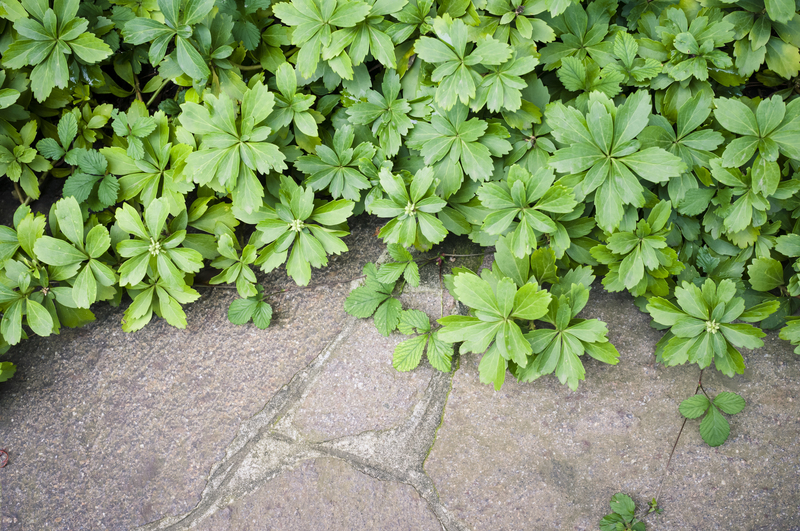Animating Soil Life via Organic Waste Conversion
Posted on 11/09/2025
Animating Soil Life via Organic Waste Conversion: Enriching Ecosystems Naturally
Healthy soil forms the foundation of sustainable agriculture and thriving ecosystems. In recent years, animating soil life via organic waste conversion has emerged as a powerful solution to enrich soils, promote biodiversity, and close nutrient loops. By transforming organic residues into rich humus, farmers, gardeners, and city dwellers alike can boost soil vitality while responsibly managing waste. But how does organic waste conversion work, and what is its impact on the living world beneath our feet? Let's dig deep into this fascinating natural process and discover practical ways to animate soil life.

Why Animate Soil Life?
The living component of soil--its bustling community of bacteria, fungi, protozoa, nematodes, earthworms, and arthropods--is essential for soil fertility. These organisms decompose organic matter, cycle nutrients, improve soil structure, and protect plants from pathogens. Unfortunately, conventional land management and synthetic inputs can diminish soil biodiversity, leading to poorer crop yields and degraded landscapes.
Animating soil life through organic waste conversion offers a sustainable alternative. Rather than treating organic waste as a problem, we can view it as a valuable resource for restoring and regenerating soil health.
The Biological Engine: Soil Microorganisms
Soil organisms form a complex food-web, each group playing unique roles. At the base are trillions of microorganisms--bacteria, actinomycetes, and fungi. They rapidly colonize organic matter, breaking down proteins, carbohydrates, and cellulose. Fungal hyphae weave through soil aggregates, transporting nutrients and stabilizing soil structure.
- Bacteria: Fast-acting decomposers, nitrogen fixers, and disease suppressors.
- Fungi: Break down woody cellulose, form mycorrhizal partnerships with plants, enhance phosphorus availability.
- Protozoa and Nematodes: Graze on bacteria and fungi, controlling populations and releasing nutrients in plant-available forms.
- Earthworms and Arthropods: Shred and mix organic matter, aerate soil, and enhance aggregation.
Organic waste conversion animates this hidden workforce, jumpstarting decomposition and nutrient cycling.
Understanding Organic Waste Conversion: From Waste to Wealth
What Is Organic Waste?
Organic waste includes all biodegradable material from plants and animals--kitchen scraps, yard trimmings, manure, crop residues, and more. If left unmanaged, these wastes can contribute to greenhouse gas emissions and pollution. However, when converted properly, they become the primary feedstock for animating soil life.
Key Methods for Organic Waste Conversion
- Traditional Composting: Layering green and brown materials, aerating, and maintaining moisture to promote microbial breakdown.
- Vermicomposting: Employing earthworms such as Eisenia fetida to rapidly process organic matter and produce rich castings.
- Bokashi Fermentation: Using beneficial microbes (such as lactic acid bacteria and yeasts) to ferment kitchen waste anaerobically, preserving nutrients and enabling their incorporation into soil.
- Mulching & Surface Application: Applying organic residues directly to the soil surface, stimulating in-situ decomposition by soil biota.
Each method has distinct advantages and can be tailored to different scales and contexts.
How Organic Waste Conversion Animates Soil Life
Boosts Microbial Populations
Applying compost, vermicompost, or fermented material directly introduces beneficial microorganisms. These microbes multiply rapidly and continue decomposition in the soil matrix, increasing soil microbial biomass and diversity.
Enhances Soil Aggregation
Humic substances, glomalin (a sticky protein excreted by arbuscular mycorrhizal fungi), and polysaccharides from bacteria act as natural "glues." They bind soil particles into stable aggregates. This improves aeration, water infiltration, and root growth, while reducing erosion.
Stimulates Higher Soil Life
As bacteria and fungi multiply, they become food for protozoa, nematodes, and microarthropods, which in turn attract earthworms and predatory beetles. This trophic cascade strengthens the entire ecosystem, improving pest suppression and organic matter breakdown.
Accelerates Nutrient Cycling
Through their metabolic processes, soil organisms convert organic nitrogen, phosphorus, and sulfur into mineral forms that plants can uptake. This continual cycling sustains fertility naturally, reducing dependence on synthetic fertilizers.
Suppression of Soil-borne Diseases
Many composts and decomposing residues harbor microbial antagonists--bacteria and fungi that outcompete or even prey on plant pathogens. This natural "biocontrol" mechanism enhances soil resilience and can reduce losses due to soil-borne diseases.
Best Practices for Animating Soil Life
To maximize the impact of organic waste conversion for soil animation, follow these evidence-based best practices:
- Diversify Your Feedstocks: Combine various organic wastes for a balanced carbon-to-nitrogen (C:N) ratio. Blend green materials (fruit peels, coffee grounds) with browns (dry leaves, straw) for optimal decomposition.
- Maintain Moisture and Aeration: Compost and soil biota require moisture and oxygen. Keep compost moist but not soggy, and turn piles or loosen layers to support aerobic microbial activity.
- Avoid Toxic Contaminants: Steer clear of heavily treated or pesticide-laden residues. These can suppress beneficial soil life. Focus on clean, natural, and food-safe organics.
- Ensure Proper Application: Spread finished compost or vermicompost in a thin, even layer or incorporate gently into the root zone. Avoid burying undecomposed material deep in the soil (except for Bokashi residues, which are pre-fermented).
- Regular Feeding: Animate soil life by feeding it regularly. Small, frequent applications of organic matter encourage stable, active communities rather than boom-bust cycles.
Case Studies: Organic Waste Conversion Brings Soil to Life
Urban Gardens: From Food Scraps to Fertile Beds
Community gardens are often at the forefront of organic waste recycling for soil animation. Groups in cities across the globe collect vegetable peels, coffee grounds, and garden clippings to produce loamy compost. Not only does this enrich their raised beds, it fosters strong earthworm populations and visibly improves plant health--testaments to the vibrant soil food web below the surface.
Regenerative Farms: Closing the Loop with Manure and Crop Residues
On regenerative farms, manure from grazing animals is composted with straw and stalks. This compost inoculates fields with billions of soil organisms, reducing disease and building long-term fertility. Farmers consistently report enhanced water retention, crumbly topsoil, and a thriving diversity of insects and birds--a ripple effect starting with animated soil life.
Home Composters: Creating Living Soil in Backyards
Even at home, diverting kitchen waste and lawn clippings to a backyard bin can transform sterile or compacted soil into a living, productive substrate. Worm bins, in particular, are popular for their speed and nutrient density. Home gardeners observe improved yields, richer colors, and reduced need for chemical inputs--proof of soil life revitalized through organic waste conversion.
Environmental and Social Benefits of Animating Soil Life
- Reduces Landfill Burden: Every ton of organic waste diverted from landfills reduces methane emissions, a potent greenhouse gas.
- Mitigates Pollution: Compost use filters and immobilizes pollutants, reducing nutrient runoff and water contamination.
- Improves Food Security: Healthier soils yield more nutritious, robust crops, bolstering food supply on local and global scales.
- Fosters Community Engagement: Composting initiatives build connections between neighbors, farmers, and markets, nurturing sustainable communities.
Common Challenges and Solutions in Organic Waste Conversion
Odor and Pest Control
Proper carbon-nitrogen balance (ideally 25-30:1), aeration, and covering fresh wastes with browns will prevent bad smells and discourage rats or flies.
Space Constraints in Urban Settings
Compact systems like worm bins, bokashi buckets, or in-vessel composters allow even apartment dwellers to participate in soil life animation through organic waste.
Time and Labor Management
Passive methods, such as mulching or static compost heaps, require less time but may decompose more slowly. Choose the method that best fits your schedule and goals.
Unwanted Weeds or Pathogens
Ensure that compost reaches temperatures of 55-65?C (130-150?F) for several days to kill weed seeds and pathogens. Bokashi fermentation can also suppress pathogens before soil application.
Frequently Asked Questions About Soil Animation and Organic Waste Reuse
-
What types of organic waste are safe for composting?
Most vegetable and fruit scraps, coffee grounds, tea leaves, egg shells, leaves, straw, and manure from herbivores. Avoid meat, dairy, and heavily processed foods. -
How long does organic waste take to become beneficial soil amendment?
Compost can mature in 2-6 months, depending on materials and management. Vermicompost is often ready in 2-3 months. Fermented bokashi can be buried after 2 weeks. -
Can I use unfinished compost to animate soil life?
Partially decomposed material can be surface-applied as mulch but may rob soil of nitrogen if incorporated too soon. Let compost mature for best results. -
Will animating soil life eliminate the need for fertilizers?
Proper organic waste conversion can significantly reduce or even eliminate the need for synthetic fertilizers, especially when combined with crop rotation and cover cropping.

The Future: Scaling Up Soil Animation through Circular Bioeconomy
Cities, farms, and agro-industries are increasingly recognizing organic waste as a cornerstone of the circular bioeconomy. Technologies such as decentralized composting, biogas fermentation, and commercial vermicomposting are being scaled to keep nutrients cycling locally. Legislation in many regions now mandates organic waste diversion, unlocking economic and environmental benefits.
The vision is simple yet profound: By animating soil life via organic waste conversion, we can restore natural cycles, regenerate landscapes, and create resilient food systems for generations to come.
Conclusion: Bringing Life Back to Soil, Naturally
*Animating soil life via organic waste conversion* is more than just a waste management practice--it is a root-to-root revolution in how we steward the land. By returning organic matter to the soil, we tap into a powerful cycle of decomposition, renewal, and growth. The results? Richer harvests, healthier ecosystems, and a lighter footprint on the planet.
Whether you're a farmer, gardener, policy-maker, or eco-conscious citizen, you have a role to play. Start today by separating your organics, experimenting with composting methods, and observing the life teeming in your soil. Together, we can animate the living world beneath our feet and sow the seeds of a healthier future for all.

